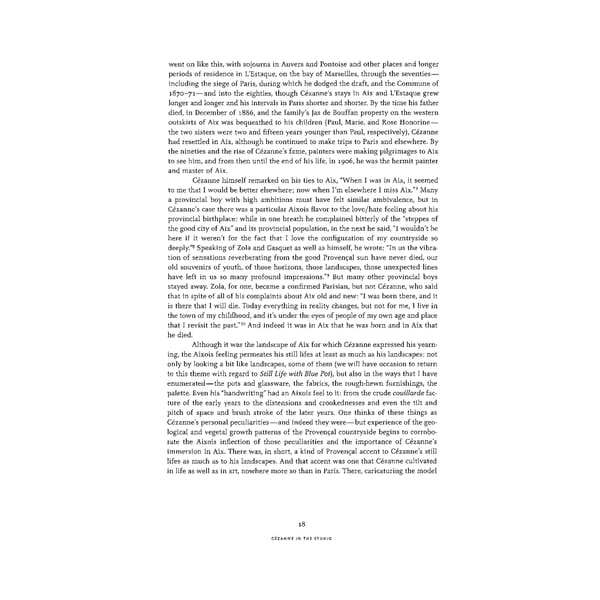went on like this, with sojourns in Auvers and Pontoise and other places and longer periods of residence in L'Estaque, on the bay of Marseilles, through the seventies — including the siege of Paris, during which he dodged the draft, and the Commune of 1870-71—and into the eighties, though Cezanne's stays in Aix and L'Estaque grew longer and longer and his intervals in Paris shorter and shorter. By the time his father died, in December of 1886, and the family's Jas de Bouffan property on the western outskirts of Aix was bequeathed to his children (Paul, Marie, and Rose Honorine — the two sisters were two and fifteen years younger than Paul, respectively), Cezanne had resettled in Aix, although he continued to make trips to Paris and elsewhere. By the nineties and the rise of Cezanne's fame, painters were making pilgrimages to Aix to see him, and from then until the end of his life, in 1906, he was the hermit painter and master of Aix. Cezanne himself remarked on his ties to Aix, "When I was in Aix, it seemed to me that I would be better elsewhere; now when I'm elsewhere I miss Aix."7 Many a provincial boy with high ambitions must have felt similar ambivalence, but in Cezanne's case there was a particular Aixois flavor to the love/hate feeling about his provincial birthplace: while in one breath he complained bitterly of the "steppes of ;; the good city of Aix and its provincial population, in the next he said, "I wouldn't be here if it weren't for the fact that I love the configuration of my countryside so 8 deeply." Speaking of Zola and Gasquet as well as himself, he wrote: "In us the vibra- tion of sensations reverberating from the good Provencal sun have never died, our old souvenirs of youth, of those horizons, those landscapes, those unexpected lines have left in us so many profound impressions."9 But many other provincial boys stayed away. Zola, for one, became a confirmed Parisian, but not Cezanne, who said that in spite of all of his complaints about Aix old and new: "I was born there, and it is there that I will die. Today everything in reality changes, but not for me, I live in the town of my childhood, and it's under the eyes of people of my own age and place 10 that I revisit the past." And indeed it was in Aix that he was born and in Aix that he died. Although it was the landscape of Aix for which Cezanne expressed his yearn- ing, the Aixois feeling permeates his still lifes at least as much as his landscapes: not only by looking a bit like landscapes, some of them (we will have occasion to return to this theme with regard to Still Life with Blue Pot), but also in the ways that I have enumerated—the pots and glassware, the fabrics, the rough-hewn furnishings, the palette. Even his "handwriting" had an Aixois feel to it: from the crude couillarde fac- ture of the early years to the distensions and crookednesses and even the tilt and pitch of space and brush stroke of the later years. One thinks of these things as Cezanne's personal peculiarities—and indeed they were—but experience of the geo- logical and vegetal growth patterns of the Provencal countryside begins to corrobo- rate the Aixois inflection of those peculiarities and the importance of Cezanne's immersion in Aix. There was, in short, a kind of Provencal accent to Cezanne's still lifes as much as to his landscapes. And that accent was one that Cezanne cultivated in life as well as in art, nowhere more so than in Paris. There, caricaturing the model 18 CEZANNE IN THE STUDIO
 Cézanne in the Studio: Still Life in Watercolors Page 32 Page 34
Cézanne in the Studio: Still Life in Watercolors Page 32 Page 34